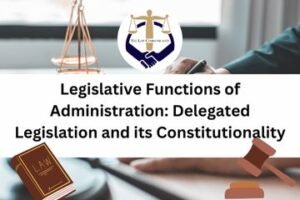Understanding Section 5 of Hindu Marriage Act, 1955: A Simple Guide
Written by Meher Makwana
Introduction
The Hindu Marriage Act is a codified law passed by the house in the year 1955, it regulates and safeguards the marriage rights and is applicable to Hindus, Buddhists, Sikhs or Jains. It is clear that the provision is discretionary and not mandatory by its nature. The act also has an umbrella effect on all the people who by religion as not Muslim, Christian, Parsis or Jewish. Section 5 which is part of Chapter II lays down the conditions that are required to be fulfil to consider the marriage valid.
The provision considered is only for the marriages between two people who by religion are Hindu which also includes the religion above mentioned or Hindu by birth, conversion, or by any means. The conditions laid down are said to be mandatory for the marriage to be recognized and not be void. The objective of the reasons behind the provision will also be deeply explained in the article with the landmark case laws and recent case laws.
A marriage may be solemnized between two Hindus if the following conditions are fulfilled namely,
1. Neither of the parties to the marriage should have a spouse living at the time of the marriage.
- The parties must be unmarried or widowed or any previous marriages MUST have been dissolved by divorce or annulment. It was also to get away with the prevalence of bigamy which is mentioned in Sections 494 and 495 of the Indian Penal Code, the Hindu Marriage Act thus thereby ensuring the practice of bigamy is non-existential.
2. The parties at the time of the marriage:
- Is incapable of giving a valid consent to it in consequence of unsoundness of mind; or
- Though capable of giving valid consent, has been suffering from mental disorder of such a kind or such an extent as to unfit for marriage and procreation of children; or
- Has subject to recurrent attacks of insanity.
The presence of these three conditions will be considered as a valid ground that cannot be left unnoticed for a valid Hindu marriage to take place, one among which should not be breached by one of the parties otherwise the nature of the marriage stands voidable. According to section 5(b) of the act, a marriage can be dissolved even though the parties are capable of giving legal consent, and have been expecting a mental condition that renders them unfit for marriage. In the case of Alka Sharma v. Chandra Sharma, the women felt chilly uneasy and frigid on the first night of the marriage. She was unwilling to participate in the sexual act and also to explain why she had urinated on the veranda in front of the whole family, thus making the husband a legal action to dissolve the marriage As decided by the honourable court, the marriage stood null.
3. The bridegroom has completed the age of twenty-one years old and the bride-to-be age of eighteen at the time of the marriage.
To motive behind the third condition is self-explanatory in nature, it aims to protect the people from the cruelty of child marriages. In V. Prema Kumari, the court held that the Hindu Marriage Act, 1955 does not have a provision that will allow minor children to avoid marriages after attaining the age of the majority, thereby declaring the third condition as voidable.
4. The parties to the marriage are not within the degree of prohibited relationship unless the custom or usage governing each of them permits a marriage between the two;
The parties who are within a degree of prohibited relationship are:
- If one is another lineal ascendant or
- If one was married to or had a descendant from another’s lineal ascendant;
- If one was a spouse of the other’s brother, father, mother, grandfather, grandmother, or any other relative
- If one of the two brothers or sister, aunt or nephew, uncle and niece a child of brother or sister or children of two brothers or sisters.
The marriage which falls under these above-mentioned degrees is void and is a banned relationship. It is valid under the exception of it being under a valid custom, the custom being certain, reasonable, and not in conflict with public policy.
5. The parties are not in the sapindas of each other unless the custom or usage governing them allows;
To put it in a simpler term it means the husband or the wife shouldn’t share the same ancestry. It extends up to as far as the third generation of the mother and the fifth generation of the father, the line is traced upwards from the individual in question.
The Delhi High Court on the well-known case Jitendra Kumar vs State & Another 2010, the marriage took place between two minor children who had fallen in love and eloped after their marriage, the girl’s father contended before the court that the marriage was invalid as it infringed the right of section 5(iii) of the Hindu marriage act, the court pointed out that neither the ground for marriage nor a voidable marriage, opined they the minor couple is free to live together without the compulsion from respective families. Taking in the view according to the judgement section 5 revolved around the 3rd condition which is in fact a major loophole of the Hindu marriage legislature.
The conflict raised herein in the Pinki and Another v. State of Haryana and Others that the fundamental rights of the petitioners to seek the protection of their “life and liberty” as enshrined under article 21 of the constitution of India viz a conceded violation of section 5( iii) of the Hindu Marriage Act, in as much a girl aged 20 years and the boy aged 20 years and 04 months claims to have married each other.
The petitioners state that they are living in constant danger as 2 of 8 have every apprehension that private respondents will catch them and carry out their threats and may go to the extent of even committing their murder. The petitioners are, therefore, running here and there and unable to find any safe place to live in the absence of protection of their life and liberty.
Both the petitioners are allegedly a run-away couple and claim to have married each other, despite not being of marriageable age forced by the circumstances triggered by the parents of the girl insisting/ forcing her to marry against her wishes with another boy, in light of the aforesaid background and the judgment rendered by Delhi High Court, it appears from the documents appended herein that the petitioners have not solemnized a valid marriage as per Sub Section (iii) of Section 5 of the Hindu Marriage Act and may be required to satisfy the validity of their marriage before an appropriate Forum in the event of same being put to challenge. Therefore according to this said case the marriage needs to be SOLEMIZED and also one of the main features of the Hindu Marriage Act.
Conclusion
As we come to the end it becomes a need to mention that the section 5 of the act holds an appreciated value from its harmonious relationship between the Hindu customs and the formulation of societal needs, the Hindu Marriage Act has been a remarkable statute to successfully govern the Hindu law and the traditions.




